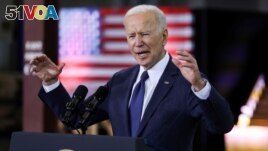31 March 2021
American President Joe Biden announced on Wednesday a $2 trillion spending plan that is, in his words, "a once-in-a-generation investment in America."
Biden said it is "the largest American jobs investment since World War II." He added it will create millions of jobs, grow the economy and help the country compete against China.
The plan is the first of Biden's two proposals called the American Jobs Plan and the American Families Plan. He promised to release the second plan in a few weeks.

U.S. President Joe Biden speaks about his $2 trillion infrastructure plan during an event to tout the plan at Carpenters Pittsburgh Training Center in Pittsburgh, Pennsylvania, U.S., March 31, 2021. (REUTERS/Jonathan Ernst)
The Biden administration said in a statement that the American Jobs Plan provides money to improve the country's roads and bridges and to build charging stations for electric vehicles. Other projects include housing for the poor, expansion of high-speed internet service, and money for research and manufacturing.
The administration said the plan would be paid for by raising the U.S. corporate tax rate from 21 to 28 percent, establishing a minimum tax rate on corporate earnings, and ending tax breaks for fossil fuel companies and others.
What's in the $2 trillion spending plan?
The Biden administration said the largest amount of money, $621 billion, would go to transportation projects. These include fixing 32,000 kilometers of highways, repairing 10,000 bridges and building 500,000 charging stations. The plan is designed to push the nation's automobile industry to build more electric vehicles.
The plan includes $400 billion to expand home-based care for older people and the disabled. One of the largest investments includes $213 billion to help build housing for the poor. Another $111 billion will go to new water and sewage system for homes. High-speed internet, clean energy for electrical systems and public schools will each receive a $100 billion investment.
The plan will also invest more than $500 billion to help manufacturing in the country, retrain workers and support research and development.
Biden announced the plan in an appearance in Pittsburgh, Pennsylvania, the same city in which he launched his presidential campaign.
The city once famous for its steel factories was central to the rise of American industrial power. As steel manufacturing disappeared over time, Pittsburgh re-invented itself as a center of health care, technology and academic research.
What's next for the plan?
The new spending proposal came just 20 days after Biden signed into law a $1.9 trillion spending plan to help Americans affected by the coronavirus health crisis. Lawmakers in the president's Democratic Party have expressed support for the plan. Republican Party lawmakers have criticized it.
White House press secretary Jen Psaki said the plan is "about making an investment in America — not just modernizing our roads or railways or bridges but building an infrastructure of the future."
Mitch McConnell, the leader of Senate Republicans, said he is "not likely" to support the spending proposal. He said the plan will result in "more borrowed money, and massive tax increases on all the productive parts of our economy."
McConnell told reporters that Biden spoke to him about the spending plan in a call on Tuesday.
The Business Roundtable is an organization of American business leaders. It supports what it calls "user pay" models for infrastructure building. And the U.S. Chamber of Commerce, a business interest group, called Biden's plan "dangerously misguided" in how it expects to pay for infrastructure improvement.
At the same time, some members of Biden's own Democratic party think the infrastructure spending plan should be bigger.
Rep. Alexandria Ocasio-Cortez of New York called the plan "not nearly enough" in a Twitter post. She noted that it calls for spending $2.25 trillion over 10 years as compared to the coronavirus spending plan of $1.9 trillion for this year alone.
The plan, Ocasio-Cortez added, "Needs to be way bigger."
I'm Caty Weaver.
Hai Do wrote this story for Learning English. Caty Weaver was the editor.
______
Words in This Story
infrastructure - n. basic equipment and structures such as roads and bridges
fossil fuel - n. fuel such as gas or coal
academic - adj. relating to schools and education











